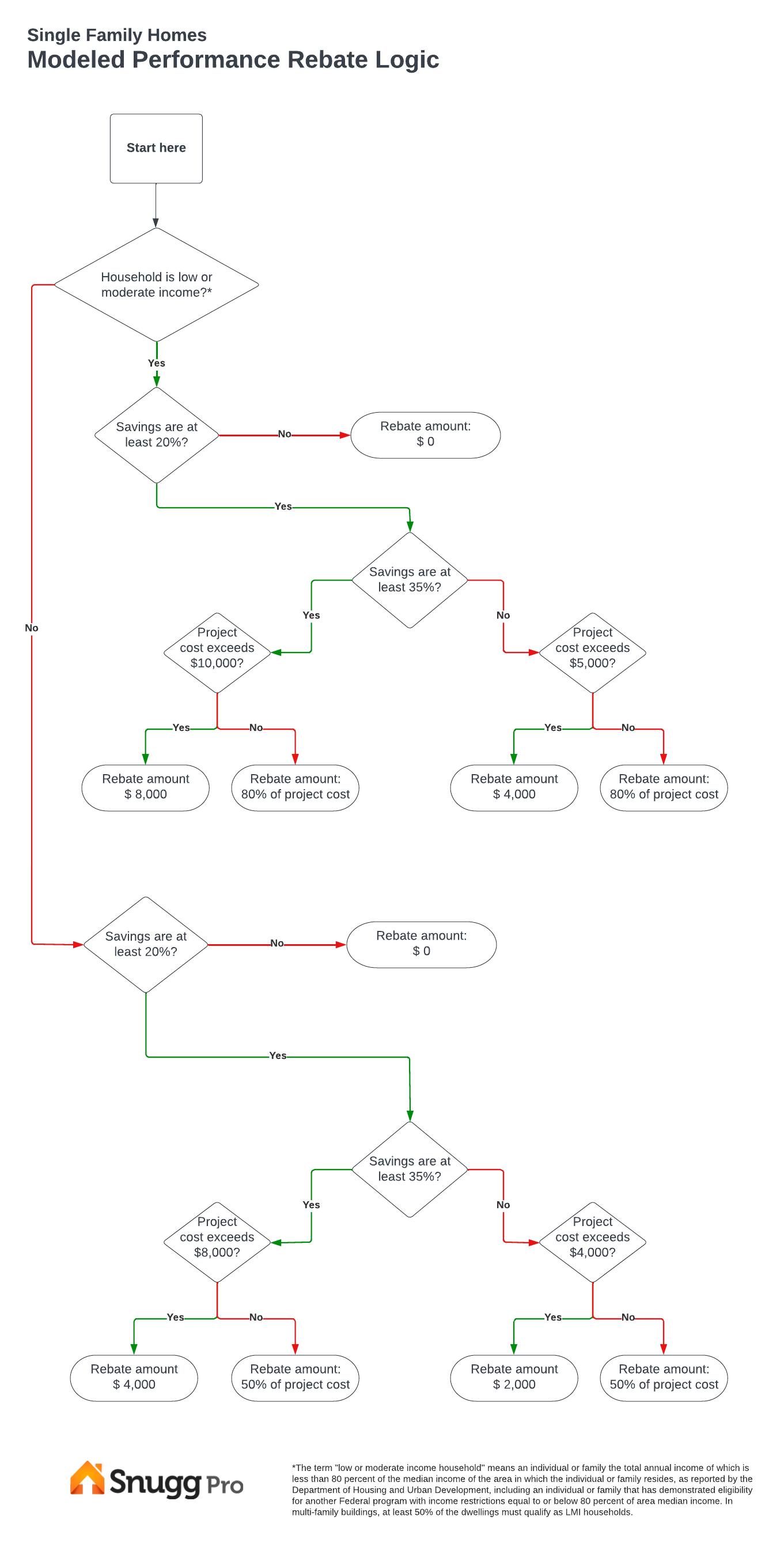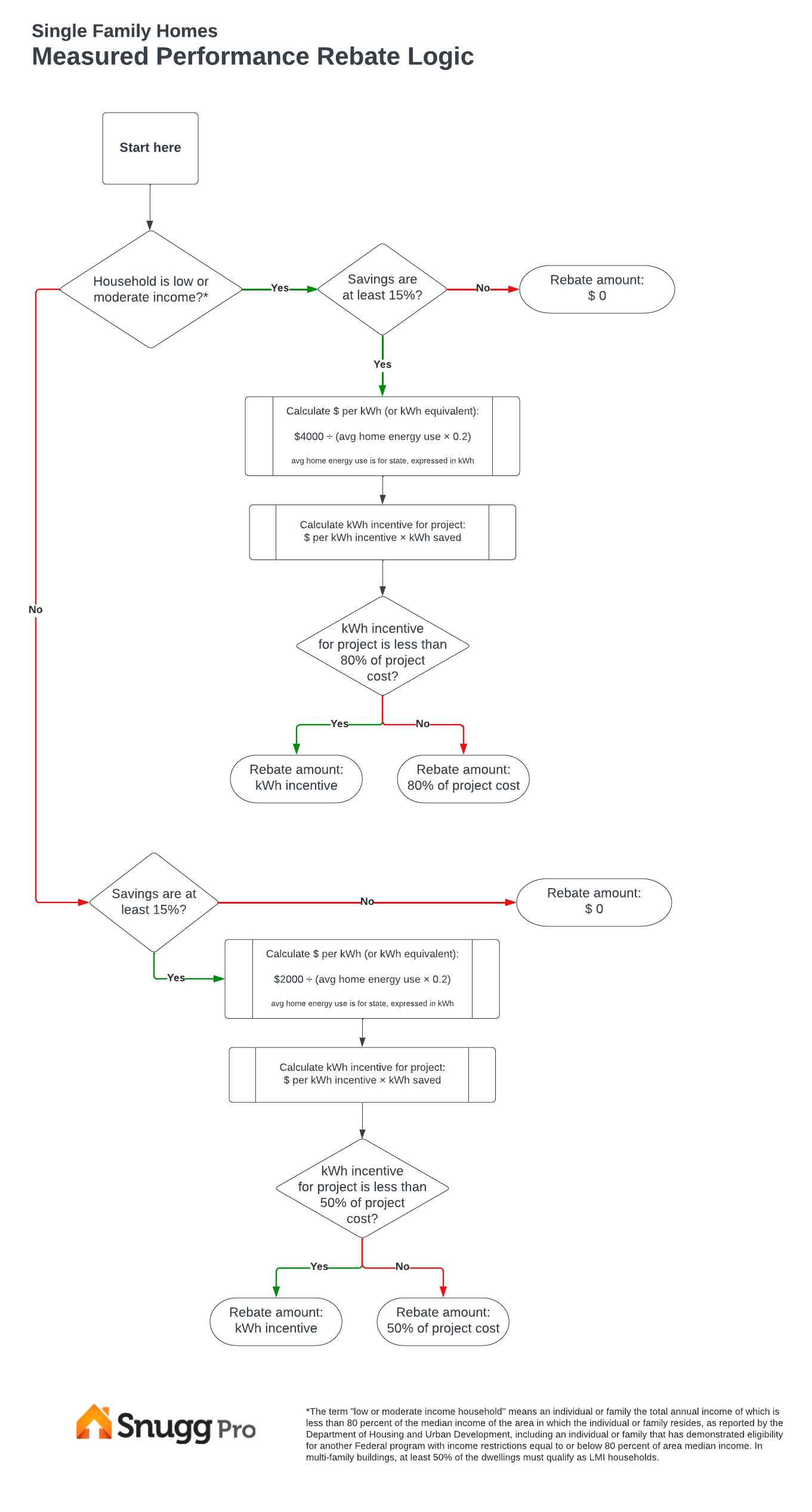Author's Note: This article will be updated as more details about the HOMES program become available. HOMES is an acronym for Home Owner Managing Energy Savings.
The new Inflation Reduction Act (I.R.A.) of 2022, signed by President Biden on August 16, reserves $4.3 billion for state energy offices to develop and implement a HOMES Rebate Program. In this article, we’ll expand on some of the practical implications of this program, focusing on single-family homes. This is different from the high-efficiency electric home rebate program also present in the new climate bill which we’ll cover in the next blog post.
Types of rebates for the HOMES Rebate Program
Type 1: Modeled Performance Rebates
Try our HOMES Rebate Calculator →
Modeled performance in this context requires the use of a BPI-2400 compliant energy modeling software like Snugg Pro to generate a base and proposed retrofit energy model that is calibrated to historical energy usage.
The standard was created by the Building Performance Institute for single family detached buildings and certain multi-family buildings where each dwelling has distinct mechanical systems and direct access to the outdoors. You can read the BPI-2400 standard here.
See also: The BPI-2400 standard in the context of the HOMES program.
Type 2: Measured Performance Home Rebate
This rebate type is in line with the pay-for-performance approach where the rebate is issued on the basis of actual savings. The use of an approved open-source measurement and verification (M&V) software, such as OpenEE Meter, is required for this type of rebate.
The measured performance approach does not technically require an energy model since the actual consumption pre and post retrofit is used to calculate rebates. That said, it’s still a good practice to perform a BPI 2400 compliant energy model to set ballpark expectations for both the homeowner and the aggregator.
According to the text of the bill, the rebate calculationr for measured energy savings is as follows. It is not clear from the language in the bill whether it is the lesser of the two above options but we are assuming this is the case based on other language around the HOMES rebate logic
Notable Requirements for the HOMES Rebate Programs
State energy offices seeking to avail of funding for a HOMES Rebate Program must provide a plan that includes the following:
Requirement 1: Comprehensive Savings Reporting
HOMES Rebate Programs will need to calculate savings based on time, location and greenhouse gas emissions.
Requirement 2: Third-Party Certified Upgrades
The quality assurance process requires a certificate of completion that must:
Be provided by the contractor AND
Be certified by a third party to the homeowner AND
Describe the work performed, the equipment and materials installed, and the projected energy savings or energy generation to support accurate valuation of the retrofit;
If you are familiar with Home Performance with Energy Star programs (HPwES), this is a close cousin of the HPwES Certificate of Completion. In this context, the third party verifier is typically the program implementer. Program implementers could be a government entity, a local consulting business or an implementation firm like CLEAResult or ICF.
Requirement 3: Boots on the ground
The program design should plan for trade allies that will perform the home energy retrofit for modeled performance programs or aggregators for measured performance programs. There is an extra incentive for them to perform their work in disadvantaged communities.
These parties will be entitled to claim a $200 rebate per home, provided that both of these conditions are true:
- The home is located in a disadvantaged community
- The home has been awarded a rebate under the HOMES rebate program
Requirement 4: No double-dipping into rebates for the same single upgrade
It is the program’s responsibility to ensure that a homeowner or aggregator does not receive another rebate for the same upgrade through any other federal grant or rebate program. For example, an upgrade which receives a rebate under the HOMES Rebate Program is barred from getting a rebate under the high-efficiency electric home rebate program.
Closing thoughts
The funds for this HOMES Rebate Program will remain available until September 30, 2031. With funding from HOMES and other I.R.A. incentives flowing through State Energy Offices, we can expect to see a significant increase in energy efficiency, building electrification, and home decarbonization activity across the country over the next decade. State Energy Offices will likely have to amend existing programs, design entirely new ones in order to submit funding applications, possibly with assistance from program implementers and technology partners. Rolling out HOMES Rebate Programs may also require coordination with utilities who already manage rebate programs in many US states.
The HOMES Rebate Program seems optimally geared towards building envelope measures such as insulation and air sealing but could also be used for appliance and HVAC replacements. It's worth noting that the program takes an agnostic whole-house efficiency approach that isn't specifically targeting building electrification. This means you could theoretically use the HOMES rebate towards an energy efficient natural gas furnace. For building electrification, we'll need to look to the High-Efficiency Electric Home Rebate Program which offers potentially larger rebates at point-of-sale for appliances such as space conditioning heat pumps, heat pump water heaters and more. This will be the subject of a separate article in which we'll also explore how to take advantage of both rebate programs without double-dipping for any single upgrade.
Resources:
If you have questions or comments about this article, you can send us a message here.
About Snugg Pro
Snugg Pro is a BPI-2400 compliant, cloud-based desktop, tablet and smart-phone application that powers collaboration between home performance programs and their trade allies. Snugg Pro is a technology partner in many of the US’ leading energy efficiency programs, big and small. We provide scalable program management, real-time visibility of energy audits, live rebate calculations, document storage, workflow (QA) management, API integrations capabilities and more. Contact us here to discuss your program requirements.
If you work with your state's Energy Office or are part of the design process for a HOMES Rebate Program funding application, Snugg Pro can help with your HOMES program rollout. In addition to generating BPI-2400 compliant energy models, our software suite helps program implementers manage their trade allies, track jobs, assign rebates, and perform quality assurance at scale.


